

A new Oligocene site with terrestrial mammals and a selachian fauna from Minqar Tibaghbagh, the Western Desert of Egypt
HENDRIK JAN VAN VLIET, ANNE S. SCHULP, GEBELY A.M.M. ABU EL-KHEIR, THEO M. PAIJMANS, MARK BOSSELAERS, and CHARLES J. UNDERWOOD
Van Vliet, H.J., Schulp, A.S., Abu El-Kheir, G.A.M.M., Paijmans, T.M., Bosselaers, M., and Underwood, C.J. 2017. A new Oligocene site with terrestrial mammals and a selachian fauna from Minqar Tibaghbagh, the Western Desert of Egypt. Acta Palaeontologica Polonica 62 (3): 509–525.
A new fossil site at Minqar Tibaghbagh, east of Siwa, in the Egyptian Western Desert is described. This represents the first place in Egypt outside the Fayum Depression yielding Paleogene, terrestrial mammals. Initial studies indicate the presence of palaeomastodonts, hyracoids, and anthracotheres, presumably early Oligocene in age. As only surface prospecting has been performed, more taxa will almost certainly be discovered in future investigations here and probably also elsewhere in the surroundings. A comparison is made with the most important contemporaneous sites in Libya and Egypt that yield terrestrial mammal remains. The selachian fauna from a higher level in the section confirms the Paleogene age of the subjacent strata. It is compared with selachians faunas from the early Oligocene Eastern Tethys Ocean at other places (the Fayum Depression in Egypt, and sites in Oman and Pakistan), and differs from these sites in being fully marine. Contrary to earlier studies, the open marine mudstones of the Daba’a Formation at Minqar Tibaghbagh are overlain by Paleogene marine sediments of most probably early Oligocene age and not early Miocene marine sediments as previously reported. These strata represent not only a new site with great potential for future finds, but also allows for biostratigraphic correlation.
Key words: Mammalia, Palaeomastodontidae, Hyracoidea, Anthracotheriidae, Chondrichthyes, Oligocene, Egypt.
Henk Jan van Vliet [henkjanvanvliet@yahoo.com] and Theo M. Paijmans [tpaymans@yahoo.com], Abel Tasmanstraat 41, 3531 GS Utrecht, The Netherlands.
Anne S. Schulp [anne.schulp@naturalis.nl], Naturalis Biodiversity Center, Darwinweg 2, 2333 CR Leiden, The Netherlands, and Faculty of Earth and Life Sciences, the Vrije Universiteit Amsterdam, De Boelelaan 1105, 1081 HV Amsterdam, The Netherlands.
Gebely A.M.M. Abu El-Kheir [gebely2006@scinv.au.edu.eg], Assiut University, Assiut 71591, Egypt.
Mark E.J. Bosselaers [mark.bosselaers@telenet.be], Koninklijk Belgisch Instituut voor Natuurwetenschappen, Vautierstraat 29, 1000 Brussel, Belgium; and Koninklijk Zeeuwsch Genootschap der Wetenschappen, Koudsteensedijk 7, 4331 JE Middelburg, The Netherlands.
Charles J. Underwood [c.underwood@bbk.ac.uk], Department of Earth and Planetary Science, Birkbeck College, Malet Street, London WC1E 7HX, UK.
Received 18 January 2017, accepted 16 May 2017, available online 16 August 2017.
Copyright © 2017 H.J. van Vliet et al. This is an open-access article distributed under the terms of the Creative Commons Attribution License (for details please see http://creativecommons.org/licenses/by/4.0/), which permits unrestricted use, distribution, and reproduction in any medium, provided the original author and source are credited.
Introduction
Late Eocene and Oligocene terrestrial mammal fossils are known from relatively few sites across Africa and Arabia (Holroyd et al. 1996; Seiffert 2010). Presently not more than about 30 sites are known in the whole continent of Africa (e.g., Gheerbrant et al. 1998; Seiffert 2010: table 2.1; Gutiérrez 2011). The Fayum Depression in Egypt is famous for its remains of middle to late Eocene marine mammals and latest Eocene to early Oligocene terrestrial mammals (Simons and Rasmussen 1990). Non-marine mammals of similar age have not previously been recorded from elsewhere in Egypt. This study performed under auspices of the Egyptian Environmental Affairs Agency (EEAA), shows that Minqar Tibaghbagh in the Western Desert of Egypt is not only a new fossil site rich in late Eocene marine mammals (Van Vliet and El-Kheir 2010), but also a new site with locally abundant remains of presumably early Oligocene terrestrial mammals, that was until now unknown. Moreover, the described selachian fauna is the only known fully marine assemblage from the Eastern Tethys Ocean of Oligocene age. All formerly described assemblages from this region are coastal in origin.
Institutional abbreviations.—CGM, Cairo Geological Museum, Cairo, Egypt; EEAA Egyptian Environmental Affairs Agency, Cairo, Egypt.
Other abbreviations.—BOS, bed with Oligocene selachians; BOTM, bed with Oligocene terrestrial mammals.
Material and methods
The terrestrial mammal remains were collected upon a plateau at places where the original stratum is eroded by gullies. The fossils have been found by surface prospecting, mainly in a single exposure. This comprises a flat area of 530 m from west to east (between E 26°26.094’ and E 26°26.424’) and 330 m from south to north (between N 29°10.610’ and N 29°10.786’).
The selachian teeth, 8l in total, have been collected by surface prospecting from a stratum higher in the section. Four samples of chondrichtyan teeth (CGM67186, 67191, 67194, 67195, 6719527), have been taken in an area of 1390 m from west to east (between E 26°25.565’ and E 26°26.423’) and 710 m from south to north (between N 29°10.734’ and N 29°11.121’). Samples from the sequence BOTM to BOS (see Fig. 1) have been taken to investigate its foraminiferal content, but no useful elements have been found.
All fossils described are in the collections of the Cairo Geological Museum. The molar of cf. Phiomia sp. (CGM67199) has provisionally been treated with Archeoderm in the field, and the molar of Phiomia sp. (CGM67187), consisting of three pieces, has been glued, but otherwise no restorations have yet been made. The molar of Phiomia sp. (CGM67199) on Fig. 6A2 has been reconstructed by removing the fissures with Photoshop. The molar of Phiomia sp. (CGM67187) on Fig. 6C4 has been reconstructed by projection on a picture from Tobien (1978: fig. 19). The right astragalus of cf. Bothriogenys sp. (CGM67197) on Fig. 10A2, B2, C2 has been reconstructed by projection on pictures from Sileem and Hewaidy (2015: fig. 5B2, B4, B1, respectively; CGM 27350 inverted). Measurements have been taken with a ruler. Coordinates were measured with a Garmin GPSmap 60CSx.
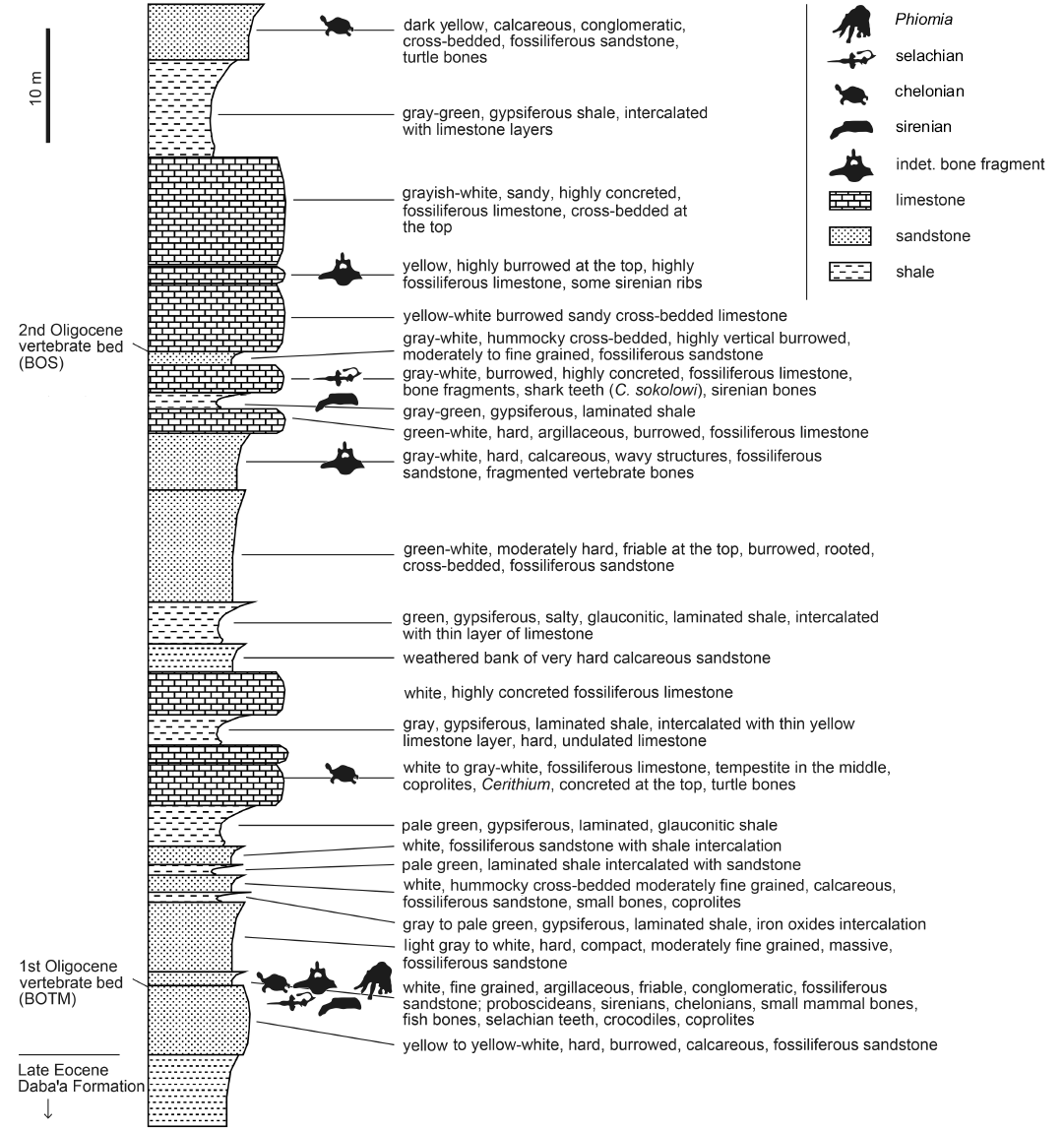
Fig. 1. Stratigraphic section of the Oligocene sediments at Minqar Tibaghbagh, Qattara Depression, Egypt. BOTM and BOS are indicated on the left of the section.
Geological setting
Tibaghbagh is located 87 km east of Siwa, at the south to south western edge of the Qattara Depression (Fig. 2). The site consists of a series of east-west oriented escarpments approximately 10 km in length. These rise above a large sabkha plain, 70–80 m below current sea level. The cliffs at the north, called “Minqar Tibaghbagh” (from Arabic minqar, cliff) are more than 175 m above current sea level.
The bedding dips very gently to the north. Cliffs of limestone, middle Eocene in age, belonging to the Apollonia Formation, are exposed in the south of the area (see Figs. 2, 3). These are the lateral equivalents of the Wadi El-Rayan Series in the Fayum Depression (Zalmout et al. 2012).
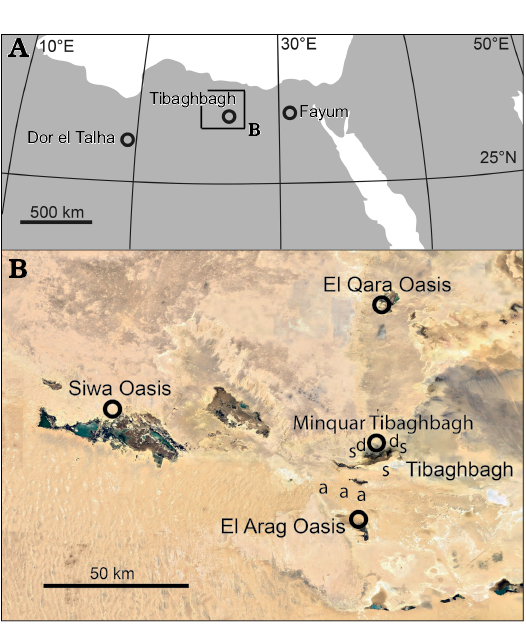
Fig. 2. A. Map with the most important early Oligocene terrestrial mammal sites of Northern Africa (Egypt: Fayum, Fayum Depression and Tibaghbagh, Qattara Depression; Libya: Dor el Talha); based upon Sanders et al. (2010b: fig. 12.2). B. Detailed map showing position of Tibaghbagh compared with other localities mentioned in this article (circles); based upon Google Maps. Abbreviations: a, outcropping of the Apollonia Formation; d, outcropping of the Daba’a Formation; s, sabkha plain.
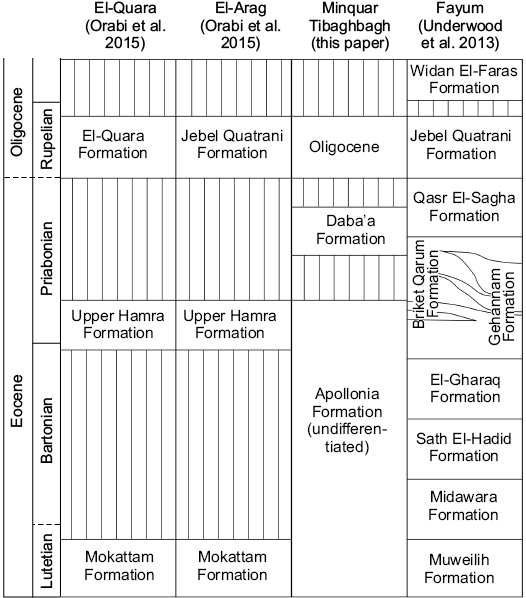
Fig. 3. Comparison between Eocene and Oligocene strata at Minqar Tibaghbagh, El-Qara, El-Arag, and the Fayum Depression, Egypt.
In the escarpments further north at Minqar Tibaghbagh, the younger mudstone of the middle to late Eocene Daba’a Formation (Shata 1953) are exposed in the lowermost 24 m of the cliffs (Antar 2011). The Daba’a Formation is considered to be a western equivalent of the Qasr El-Sagha Formation by Zalmout (2012), but is maybe synonymous with the open marine mudstone of the Gehannam Formation in the Fayum, which is strongly diachronous (e.g., Underwood et al. 2013; King et al. 2014) and lithologically very similar to the Daba’a Formation.
Archaeocetes, sirenians, and selachians are abundant in a single horizon, here about 50–60 m below current sea level (Van Vliet and El-Kheir 2010; Zalmout et al. 2012). The fauna is similar to that of the Gehannam and Birket Qarun formations. Antar (2011) figured a molar and jaw fragment of Barytherium sp. with an implication that it is from the Daba’a Formation. The Daba’a Formation is overlain by a greyish-brown sandstone layer of about 60–75 cm thick, with imprints of molluscs, as well as some unidentified bones (Fig. 4). This sandstone layer, indicative of an unconformity, is followed by a unit of more than 50 m, consisting of rather soft sandstone, mudstone, and limestone. The unit overall is strongly variegated with beds being white, green, grey, and light yellow in color (Fig. 5). The strata appear to be at least semi-marine as they contain marine molluscs and occasionally chelonian and sirenian bones. These strata have previously been considered Miocene in age (Shata 1953), and referred to the early Miocene Moghara and Mamura formations (Hantar 1990; Zalmout et al. 2012). The terrestrial mammal fauna from this unit here described, is interpreted to be early Oligocene in age and shows similarities to the fauna of the Jebel Qatrani Formation of the Fayum Depression.
Two beds with vertebrate fossils can be discerned in this unit (Fig. 1). The lowest bed is here referred to the Bed with Oligocene Terrestrial Mammals (BOTM). The uppermost is referred to the Bed with Oligocene Selachians (BOS).
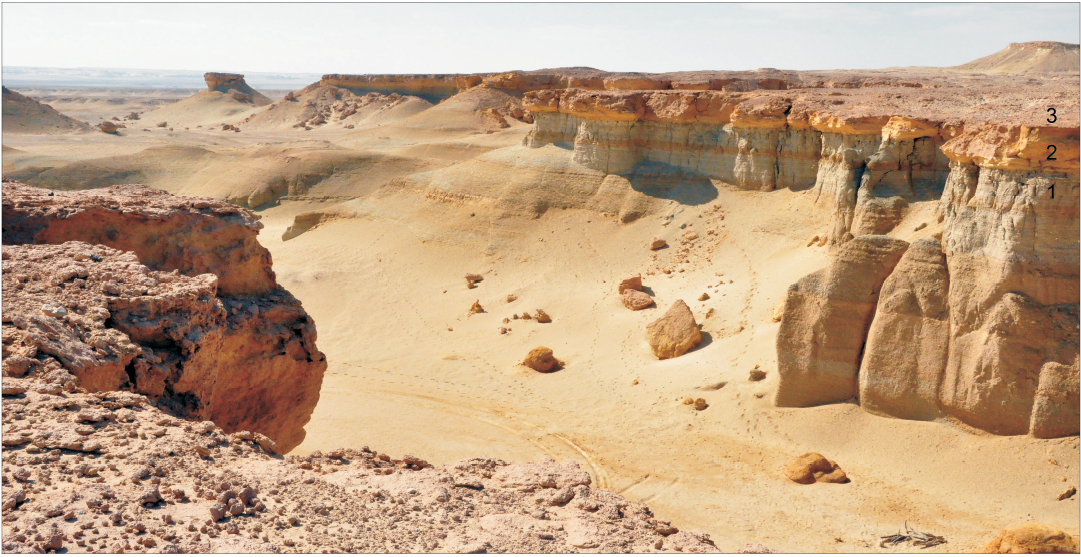
Fig. 4. Upper part of the Daba’a Formation (late Eocene) at Minqar Tibabaghbagh, Qattara Depression, Egypt (1), overlain by a thick brownish sandstone layer (2), on top of it the deflation surface and the BOTM (3). Point of view: E 26°26.360’, N 29°10.772’.
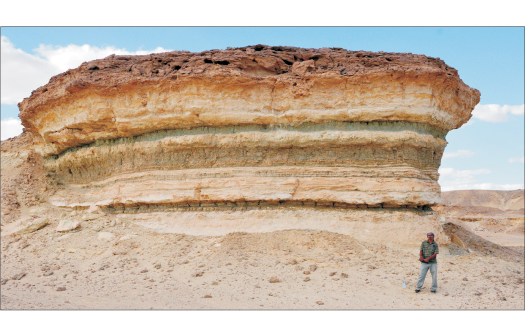
Fig. 5. Variegated layers in the lower part of the Oligocene sediments, right upon the BOTM at Minqar Tibaghbagh, Qattara Depression, Egypt. Point of view: E 26°26.380’, N 29°10.880’.
BOTM at Minqar Tibaghbagh.—The first vertebrate bed (BOTM) occurs immediately above the sandstone layer that marks the top of the Daba’a Formation. Terrestrial mammal remains are recorded from a single bed of white, poorly consolidated sandstone without clear stratification, about 0.75 m thick.
This stratum is here about 20 m below current sea level. The most common fossils are fragmented molars of palaeomastodonts as well as small, indeterminate bone fragments. Larger bones are rare and are mostly highly weathered. Wind erosion has caused extensive surface damage to many of the fossils. Pieces of silicified wood (at the main vertebrate locality up to 30 cm in length, but much larger at other places along strike) probably originate from this bed, but it is possible that they have been eroded from higher levels in the succession and washed onto this surface. The silicified wood has acquired a characteristic “desert varnish” surface. Because of the differential weathering of the overlying, less resistant beds and the indurated sandstone layer underneath, a deflation surface is present over a large area. Fossils occur in this area amongst regolith clasts and other material from higher in the succession, but the similarity in preservational style and lack of similar fossils at higher levels of the escarpment rule out that these fossils have been derived from multiple stratigraphic levels. This level, although mostly without terrestrial mammal fossils at other places, can be traced along strike for a considerable distance. A proboscidean molar fragment (CGM67192) was found at the same stratigraphic level 4.3 km to the northeast (N 29°12.548’, E 26°27.803’).
BOS at Minqar Tibaghbagh.—Higher in the section of this variegated unit, here some 34 m above current sea level, a second vertebrate-rich level was identified. Shark teeth are rather common amongst other vertebrate fossils in this whitish limestone layer.
The terrestrial mammal fauna of the BOTM is described as well as the selachian fauna from the BOS, about 50 m above the BOTM. The latter is an indication of a Paleogene age of the section below.
Systematic palaeontology
Class Mammalia Linnaeus, 1758
Superorder Paenungulata Simpson, 1945
Order Proboscidea Illiger, 1811
Suborder Elephantiformes Tassy, 1988
Family Palaeomastodontidae Andrews, 1906
Genus Phiomia Andrews and Beadnell, 1902
Type species: Phiomia serridens Andrews and Beadnell, 1902; early Oligocene, Jebel Qatrani Formation of the Fayum Province, Egypt.
cf. Phiomia sp.
Fig. 6.
Material.—Left M3? or M2 (CGM67199), distal part broken; left M3? (CGM67189); left m3 (CGM67187) from the BOTM, early Oligocene, Minqar Tibaghbagh, Qattara Depression, Egypt. For dimensions, see Table 1.
Table 1. Dimensions (in mm) of palaeomastodon
molars (cf. Phiomia sp.) from the BOTM at
Minqar
Tibaghbagh, Qattara Depression, Egypt. Abbreviations: e, estimated
dimension; N, number of specimens;
+, indicates dimensions of the fossil were originally greater.
|
Molar |
Number |
N |
Length |
Width |
|
M3? or M2? |
CGM67199 |
1 |
+72 (e67) |
+55 (e49) |
|
M3? |
CGM67189 |
1 |
71 |
+41 |
|
m3 |
CGM67187 |
1 |
+65 (e74) |
+30 (e43) |
Description.—The three described molars have three transverse, paired cusps (trilophodonty) characteristic for proboscideans (Tobien 1978). There is no cementum. The molars are relatively large compared to molars of other Paleogene proboscidean taxa but smaller than most Neogene elephantoids (Sanders et al. 2010a), indicative of a palaeomastodont (Sanders et al. 2010a). Molars are distinguished from Palaeomastodon by being bunodont, fully trilophodont, having narrow transverse valleys, a large accessory central conule in at least the first valley, well-formed wrinkled cingula and rather rugose enamel, and by the absence of pretrite and posttrite cristae (Matsumoto 1924; Tobien 1978; Sanders et al. 2004). They most closely resemble those of the palaeomastodont Phiomia (Tobien 1978: figs. 12–21; Sanders et al. 2004: figs. 7–10).
CGM67199 (Fig. 6A), a left molar, its estimated original width of 49 mm (Table 1), indicating a M3, or may be M2 (Matsumoto 1924), with multiple fractures. Due to these fractures and dental wear, adaxial conelets are not discernable anymore. It has a complete protoloph(id) and second loph(id), and a crushed tritoloph(id), with only some remnants of the posterior cingulum. Because of this damage, it is not possible to determine its position in the jaw with certainty. The proto- and second loph(id)s, as well as the posterior accessory conule, show considerable dental wear in the pretrite part. Thickness of the enamel has not been measured because of adhering sediments, as the molar has not yet been restored.CGM67189 (Fig. 6B), probably a left M3, without dental wear, only slightly abraded, and showing a still rather rugose surface of the enamel. The molar had been larger in width, as at the pretrite some parts are missing. It has three well-developed lophs, though at the posttrite, the (labial) cone of the tritoloph is smaller than the other cones. Each cone has an adaxial, smaller conelet, except the protocone (Tobien 1978: 187). There are two well-developed posterior accessory central conules, one in the first and one in the second transverse valley. The posterior cingulum is rather large and wrinkled. Thickness of the enamel has not been measured because of adhering sediments.
CGM67187 (Fig. 6C), a fragment of a left m3, slightly worn. The thickness of the enamel at the base of the crown ranges from 2.0–3.4 mm. The surface is rather smooth with some traces of rugosities especially in the valleys. Most of the lingual posttrite is preserved; the labial half, the pretrite with the dominant cusps (Sanders 2004), is broken in a longitudinal direction and lacking. The metaconid is also broken in half; the protoconid is lacking. Enough of the tritolophid is preserved to tell the place in the jaw. A wear facet is to be seen on the endoconid (Fig. 6C1, white arrow). An adaxial conelet is present on the metaconid, endoconid and on the posttrite and pretrite cusps of the tritolophid. Due to the fragmentary state the anterior cingulum is absent, as is a large part of the posterior cingulum.
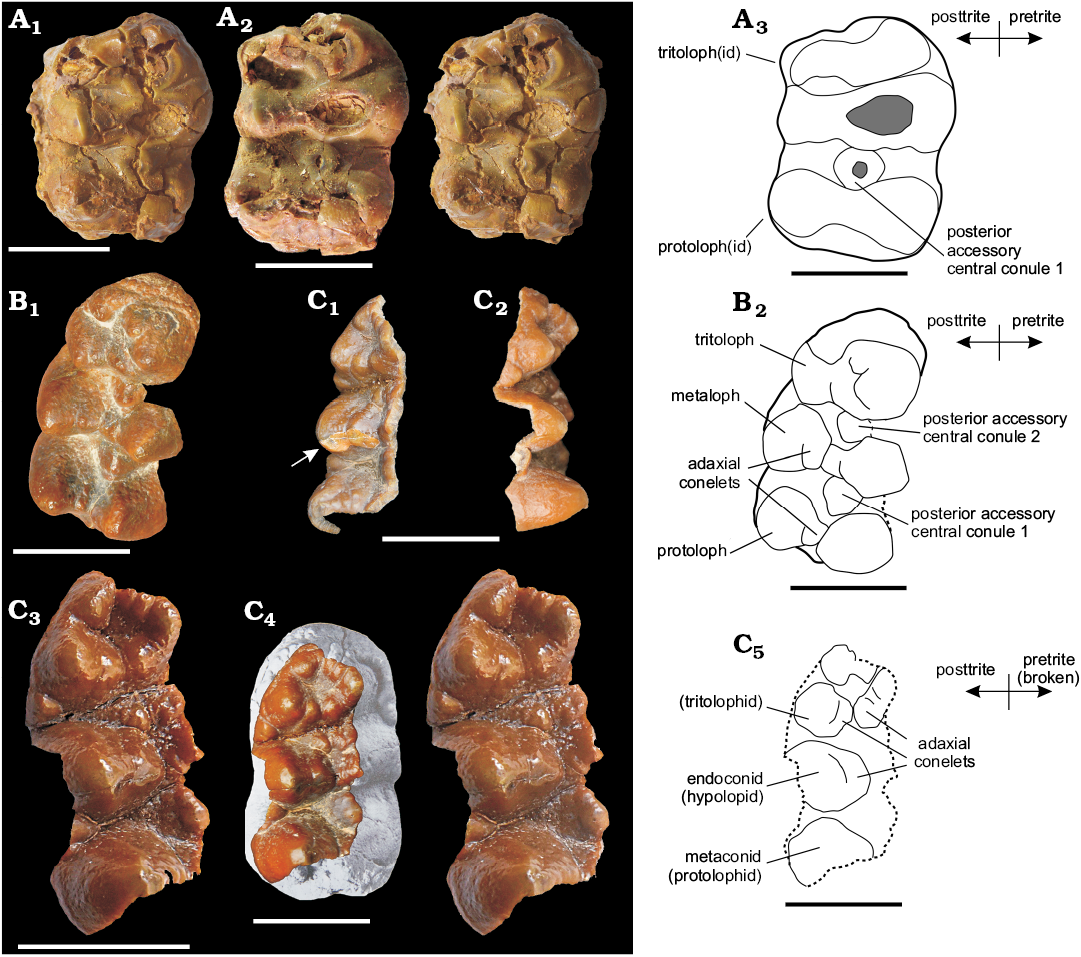
Fig. 6. Molars of palaeomastodontid proboscideans cf. Phiomia sp. (A, B) and Phiomia sp. (C) from the BOTM, early Oligocene, Minqar Tibaghbagh, Qattara Depression, Egypt. A. Left M3 or M2 (CGM67199) in occlusal view (A1 stereopair; A2, reconstruction; A3, line drawing based on this reconstruction). A2 has been reconstructed by removing the fissures with Photoshop. B. Left M3? (CGM67189) in occlusal view (B1, photograph; B2, line drawing). C. Left m3 (CGM67187) in lingual (C1, arrow points at wear facet), buccal (C2), and occlusal (C3 stereopair; C4, reconstruction; C5, line drawing) views. C4 has been reconstructed by projection on a picture from Tobien (1978: fig. 19). Anterior is downwards. Scale bars 30 mm.
Remarks.—The Palaeomastodontidae (Palaeomastodon, Phiomia) comprise the earliest of the Elephantiformes. Based upon earlier interpretations of the age of the Jebel Qatrani Formation, earlier authors agreed about the larte Eocene age of the first palaeomastodonts (e.g., Andrews 1906; Coppens et al. 1978). The general opinion is now that early Elephantiformes are not known before the ealy Oligocene, with the possible exception of Phiomia sp. indet. from the Evaporite Unit of Dor El-Talha, Libya (Sanders et al. 2010a).
The estimated dimensions of the molars from Minqar Tibaghbagh seem to be only slightly smaller or as large as the largest comparable molars of Phiomia serridens from the Fayum Depression. The molars are, however, smaller than those of the late Oligocene molars of Phiomia major from the late Oligocene Chilga Formation of Ethiopia (Sanders et al. 2004). See Fig. 7 and Age and stratigraphy.
Phiomia sp. indet. is known from the latest Eocene or early Oligocene of Libya (Sanders et al. 2010a). Phiomia serridens (including P. minor, P. wintoni, and P. osborni) is known form the early Oligocene of Egypt (Andrews and Beadnell 1902), Libya (Sanders et al. 2010a), from Tunisia (Arambourg and Burollet 1962). Phiomia sp. indet. is known from the early Oligocene of Angola (Sanders et al. 2010a). Phiomia major is known from the late Oligocene of Ethiopia in Africa (Sanders et al. 2004). Phiomia sp. indet. is also known from the early Oligocene of Oman (Sanders et al. 2010a) and the middle or late Oligocene of Saudi Arabia in Asia (Zalmout et al. 2010).

Fig. 7. Bivariate plots of Phiomia sp. cheek teeth from the BOTM, early Oligocene, Minqar Tibaghbagh, Qattara Depression, Egypt (stars) compared with Phiomia spp. from the early Oligocene Jebel Qatrani Formation, Fayum Depression, Egypt (diamonds) and Phiomia major from the late Oligocene, Chilga Formation of the Chilga Region, Ethiopia (triangles). Comparative dimensions of Phiomia serridens from Matsumoto (1924: 48, tables B, C, E, G); dimensions of Phiomia major from Sanders et al. (2004: table 2). A. M3? (or M2?) and M3?, originally the latter molar would have been larger in width (see text). B. m3 , the width is based on estimated dimensions.
Order Hyracoidea Huxley, 1869
Family Pliohyracidae Osborn, 1899
Subfamily Titanohyracidae Matsumoto, 1926
Genus Antilohyrax Rasmussen and Simons, 2000
Type species: Antilohyrax pectidens Rasmussen and Simons, 2000, early Oligocene, lower sequence of Jebel Qatrani Formation of the Fayum Depression, Egypt (Quarry L-41).
cf. Antilohyrax sp.
Fig. 8.
Material.—Incomplete left astragalus (CGM67188) from the BOTM, early Oligocene, Minqar Tibaghbagh, Qattara Depression, Egypt. For dimensions, see Table 2.
Table 2. Dimensions (in mm) of a hyracoid
astragalus, cf. Antilohyrax sp. from the
BOTM at Minqar Tibaghbagh,
Qattara Depression, Egypt. Abbreviations: N, number of specimens; +,
indicates dimensions of the fossil were
originally greater (damaged specimen).
| |
N |
Proximo-distal length |
Width |
||
|
lateral |
medial |
proximal articulation |
distal articulation |
||
|
CGM67188 |
1 |
24 |
+20 |
21 |
17 |
Description.—Left incomplete astragalus, CGM67188. In lateral view a distinctive rounded articulation fossa for the fibular malleolus is well preserved. In mediodorsal view the corpus of the astragalus shows proximally at the left side a deep concavity, the cotylar fossa. This morphology is typical for a hyracoid (Rasmussen et al. 1990; Tabuce et al. 2007).
The tibial condyle of the astragalus is projecting laterally in a prominent way and there is a square-cut notch between this condyle and the lateral side of the neck, as in modern Procaviidae (Rasmussen et al. 1990). Bone fragments are missing from the navicular articulation distally at the plantar side. At the dorsal side, the distal articulation facet with the navicular has a smooth surface, indicating that no damage did occur. The distal facet is most probably saddle-shaped like that of Antilohyrax pectidens (Rasmussen and Simons 2000). This astragalus is of a medium sized hyracoid.
Remarks.—Postcranial remains of Paleogene hyracoids have not been extensively described (Rasmussen et al. 1990: 4688). Only very few tarsal bones can be assigned with certainty to a certain species (Rasmussen and Gutiérrez 2010). The astragalus of Antilohyrax pectidens differs from all known hyracoid astragali by its saddle-shaped navicular facet (see Fig. 8D; Rasmussen and Simons 2000). Because of some damage at the plantar side of the characteristic distal facet, and also at the cotylar fossa, dimensions of CGM67188 had to be estimated, but seem to have been rather similar to the astragalus DPC 7723a described and figured by Rasmussen and Simons (2000: 172–173, fig. 6). See Figs. 8D, 9 and Age and stratigraphy. We provisionally assign the astragalus to cf. Antilohyrax sp., but emphasize that no other characteristic remains, e.g., the pectinate lower central incisors, were recovered. The genus Antilohyrax is thus far only known from the Quarry L-41 of the Fayum Depression in the lower sequence of the Jebel Qatrani Formation (Rasmussen and Simons 2000). It would be the first co-occurrence of cf. Antilohyrax sp. and Phiomia sp. described; palaeomastodonts are not known with certainty from L-41 (Seiffert 2010: 23).
The monospecific Antilohyrax pectidens is only known from the earliest Oligocene (or maybe the latest Eocene) of the Fayum Depression, Egypt in Africa (Rasmussen and Simons 2000; Sanders 2010). Titanohyracidae are known from the Eocene and Oligocene of North Africa and the Miocene of Kenya (Rasmussen and Gutiérrez 2010).
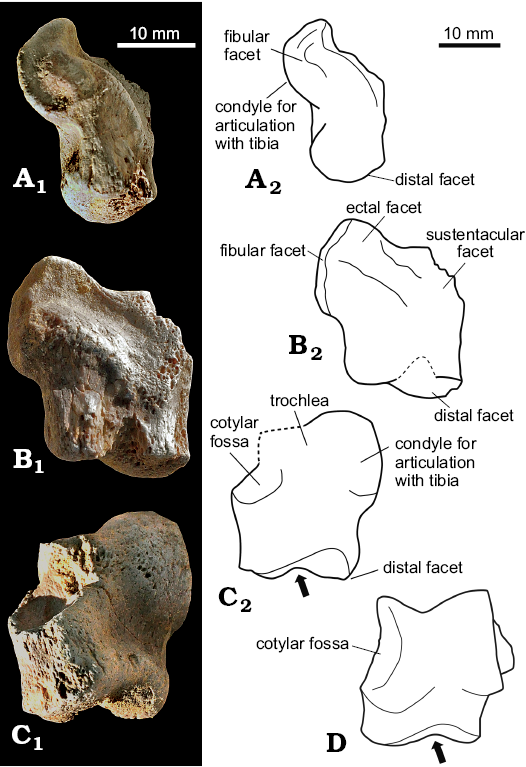
Fig. 8. Left hyracoid astragalus, cf. Antilohyrax sp. (CGM67188) from the BOTM, early Oligocene, Minqar Tibaghbagh, Qattara Depression, Egypt, in plantar (A), lateral (B), and mediodorsal (C) views (photographs: A1–C1; explanatory drawings: A2–C2). D. Outline drawing of Antilohyrax pectidens from the Fayum Depression, Egypt in dorsal view, showing the similarities with the astragalus from Minqar Tibaghbagh (based on Rasmussen and Simons 2000: fig. 6b). Arrows point at the characteristic saddle-shaped navicular facet, broken parts indicated by dotted lines.
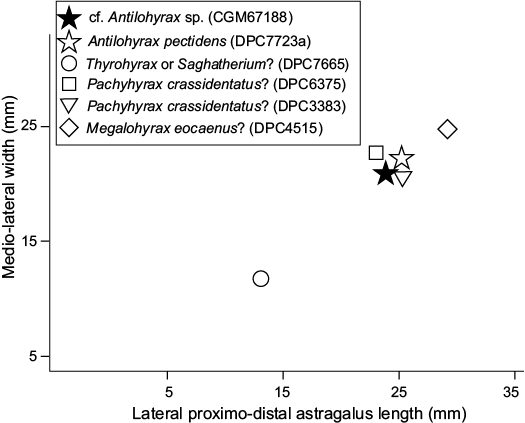
Fig. 9. Bivariate plot of a hyracoid astragalus, cf. Antilohyrax sp. (CGM67188) from the BOTM, early Oligocene, Minqar Tibaghbagh, Qattara Depression, Egypt, compared with specimens from the Jebel Qatrani Formation of the Fayum Depression, Egypt. Tibaghbagh specimen based on estimated dimensions; Thyrohyrax or Saghatherium?, Pachyhyrax crassidentatus?, and Megalohyrax eocaenus? dimensions calculated from Rasmussen et al. (1990: fig. 1a, d, e); Antilohyrax pectidens from Rasmussen and Simons (2000: fig. 6a, b).
Order Artiodactyla Owen, 1848
Family Anthracotheriidae Leidy, 1868
Subfamily Bothriodontinae Scott and Jepsen, 1940
Genus Bothriogenys Schmidt, 1913
Type species: Bothriogenys fraasi Schmidt, 1913; early Oligocene, Jebel Qatrani Formation of the Fayum Depression, Egypt.
cf. Bothriogenys sp.
Fig. 10.
Material.—Right astragalus (CGM67197) from the BOTM, early Oligocene, Minqar Tibaghbagh, Qattara Depression, Egypt. For dimensions, see Table 3.
Table 3. Dimensions (in mm) of an
anthracotheriid astragalus, cf. Bothriogenys
sp., from the BOTM at Minqar Tibaghbagh,
Qattara Depression, Egypt. Abbreviations: e, estimated dimension; N,
number of specimens; +, indicates dimensions
of the fossil were originally greater (damaged specimen).
| |
N |
Proximo-distal length |
Trochlea width |
Height |
||
|
medial |
lateral |
tibial |
distal |
medial dorso-plantar |
||
|
CGM67197 |
1 |
+56 (e58) |
+50 (e64) |
+30 (e32) |
+30 (e34) |
31 |
Description.—CGM67197, right astragalus. It has a proximal tibial and a distal cubonavicular trochlea, a “double pulley”, characteristic for an artiodactyl (Rose 2006). In lateral view, an intra-articular fossa is discernible, a feature shared by many anthracotheriids (Tsubamoto and Tsogtbaatar 2008). Overall morphoplogy is quite similar to that of Bothriogenys as figured by Andrews (1906: 188, fig. 61). Qatraniodon, the only known other anthracothere genus from the Jebel Qatrani Formation of the Fayum Depression, is excluded, as the holotype, a fragmentary dentary shows it to be a very small anthracotheriid (Holroyd et al. 2010: 846).
The proximal inner condyle or medial trochlear ridge is intact. The proximal outer condyle or lateral trochlear ridge, that would have been larger than the medial trochlear ridge, is missing. While intact, the proximal trochlea had made an oblique angle with the distal trochlea, as is still to be seen in the slightly medially deviated medial tibial trochlear ridge. In dorsal view the tibial trochlea is preserved. In plantar view the convex, the inner and outer sustentacular facets, being the articulation sites with the calcaneus, are, although weathered, still visible. The sulcus separating both sustentacular facets is hardly discernible, because weathering has created some furrows. In dorsal view, a prominent and deep digital fossa is to be seen, the hinge for the distal anterocentral tibia flange. The distal trochlea is broken, so in plantar view both the navicular and cuboid facets are lacking, as is the distal calcaneal facet. In dorsal view, the cuboid facet at the distal trochlea is only partly broken, its medial limit being a ridge. The clear groove of the distal trochlea is visible. Most parts of the navicular facet are damaged.
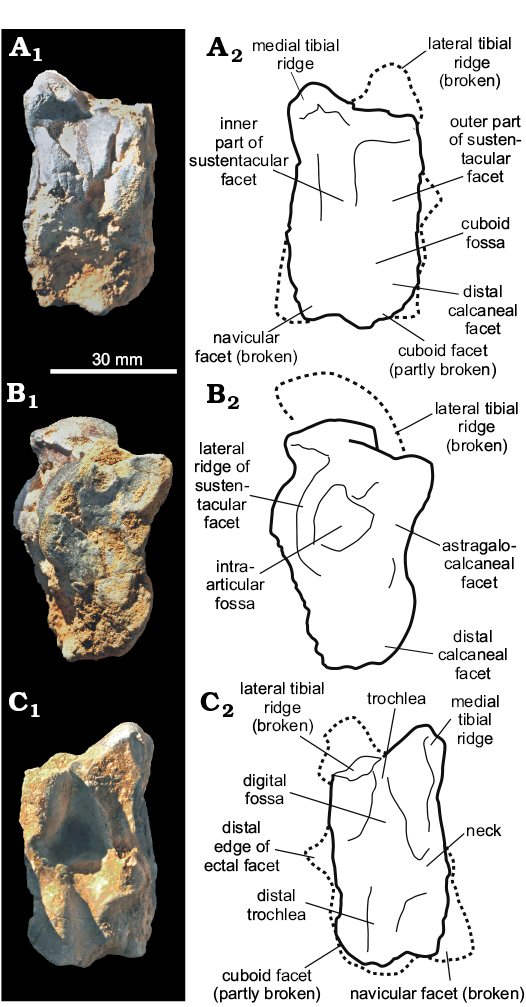
Fig. 10. Right anthracotheriid astragalus, cf. Bothriogenys sp. from the BOTM, early Oligocene, Minqar Tibaghbagh, Qattara Depression, Egypt, in plantar (A), lateral (B), and dorsal (C) views (photographs, A1–C1; explanatory drawings, A2–C2). Missing, reconstructed parts indicated by dotted lines. Drawings reconstructed by projection on pictures from Sileem and Hewaidy (2015: fig. 5B2, B4, B1, respectively).
Remarks.—In the Fayum Depression, the oldest known anthracothere, Bothriogenys sp. from the late Eocene Dir Abu Lifa Member of the Qasr El-Sagha Formation, is smaller than the early Oligocene Bothriogenys sp. of the Jebel Qatrani Formation described by Sileem and Hewaidy (2015). Bothriogenys species became larger in size through time (Sileem and Hewaidy 2015). The dimensions of the astragalus of the BOTM at Minqar Tibaghbagh had to be estimated by a reconstruction, because of some damage. The original dimensions were probably larger than the late Eocene specimen, but smaller than the early Oligocene specimens from the Fayum Depression, described by Sileem and Hewaidy (2015). See Fig. 11 and Age and stratigraphy.
The genus Bothriogenys is known from the Bartonian of Namibia (Pickford 2015a), the late Eocene and early Oligocene of Egypt and maybe Tunisia (Holroyd et al. 2010), the early Oligocene of Libya (Coster et al. 2015), and perhaps the late Oligocene of Ethiopia (Pickford 2015b) in Africa. In Asia, Bothriogenys is known from the probably early or middle late Eocene of Vietnam, early or middle late Eocene of Vietnam, the late Eocene of China and Saudi Arabia and the latest Eocene of Thailand (Ducrocq et al. 2015), the late Eocene of Japan (Tsubamoto et al. 2015) and the early Oligocene of Oman and Saudi Arabia (Pickford 2015b).
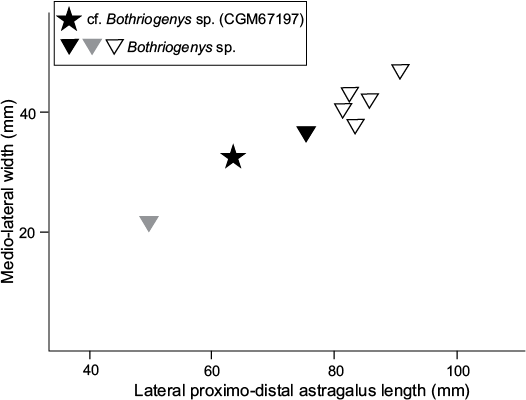
Fig. 11. Bivariate plot of an anthracotheriid astragalus, cf. Bothriogenys sp., from the BOTM, early Oligocene, Minqar Tibaghbagh, Qattara Depression, Egypt (star), compared with astragali of Bothriogenys sp., from the Jebel Qatrani (black and white triangles) and Qasr El-Sagha (grey triangle) formations of the Fayum Depression, Egypt. Original dimensions of the astragalus from Tibaghbagh have been estimated, because of damage. Dimensions of the other astragali are from Andrews (1906: fig. 61, black triangle) and Sileem and Hewaidy (2015: table 1, grey triangle and white triangles).
Class Chondrichthyes Huxley, 1880
Subclass Elasmobranchii Bonaparte, 1838
Cohort Euselachii Hay, 1902
Superorder Galeomorphii Compagno, 1973
Order Carcharhiniformes Compagno, 1973
Family Carcharhinidae Jordan and Evermann, 1896
Subfamily Carcharhininae Jordan and Evermann, 1896
Tribe Carcharhinini Jordan and Evermann, 1896
Genus Carcharhinus Blainville, 1816
Type species: Carcharias (Carcharhinus) melanopterus Quoy and Gaimard, 1824; Recent from the Island of Waigeo, west of New Guinea.
Carcharhinus sp.
Fig. 12A, F.
Material.—15 teeth (CGM67191: five, CGM67195: ten) from the BOTM and BOS, early Oligocene, Minqar Tibaghbagh, Qattara Depression, Egypt. Dimensions: height 9–13 mm, width 8–16 mm.
Description.—Teeth of this species show a low degree of heterodonty, and the slender tooth morphology usually associated with Carcharhinus lower teeth appears to be absent. Whilst upper teeth commonly outnumber lowers in collections of fossil Carcharhinus teeth (CJU personal observation), slender lowers are typically seen in any moderate sized sample and clearly differentiated from broader upper teeth. This is not the case with this species and it therefore appears that strong dignathic heterodonty was absent.
Teeth are moderately compressed linguolabially and are either of similar height and width or slightly wider than high. The cusp is robust and inclined distally. The distal part of the tooth crown comprises a low distal heel that barely rises above the top of the root. There is a well-developed notch between the cusp and heel. The cutting edge of the crown is covered with small but prominent serrations of regular size and spacing. The root is high and has a rather concave basal face. A lingual nutritive groove is seen in some teeth.
Remarks.—The material here described cannot be readily assigned to any known species, but is considered unsuitable to use as a basis for the description of a new taxon. Carcharhinus spp. from the Daba’a Formation at Minqar Tibaghbagh has been described by Van Vliet and El-Kheir (2010) and Zalmout et al. (2012). The genus Carcharhinus is known from the Lutetian to Recent of Europe, North America, Africa, Asia, Australia, Japan and New Zealand (Cappetta 2012).
Carcharhinus cf. perseus Adnet, Antoine, Hassan Baqri, Crochet, Marivaux, Welcomme, and Métais, 2007
Fig. 12E.
Material.—Three teeth (CGM67194), two badly damaged; from the BOS, early Oligocene, Minqar Tibaghbagh, Qattara Depression, Egypt. Dimensions: height 9–12 mm, width 10–12 mm.
Description.—Carcharhinids belonging to the “bull-group” with only little dignathic heterodonty, but more than in Carcharhinus sp. (above). Teeth of the upper and lower jaws are broad and blade-like. Teeth of the lower jaw are slightly more slender and the serration is less coarse. The crown of both upper and lower teeth is smaller than the linguolabially compressed root. Crown and root are equally flat at the lingual and labial sides. There is a weak lingual nutritive groove on the root, less pronounced and sometimes even absent in teeth from the upper jaw. The complete tooth is from the upper jaw.
Remarks.—The material present here is considered insufficient in quality or quantity to assign without doubt to Carcharhinus perseus, but it is either conspecific or a very similar species. Carcharhinus perseus Adnet, Antoine, Hassan Baqri, Crochet, Marivaux, Welcomme, and Métais, 2007 was originally recorded from the early Oligocene (Rupelian) Bugti Member, Chitarwata Formation of Balochistan, Pakistan (Adnet et al. 2007). It was later recognized in the earliest Oligocene Jebel Qatrani Formation of the Fayum Depression of Egypt in Africa (Murray et al. 2014).
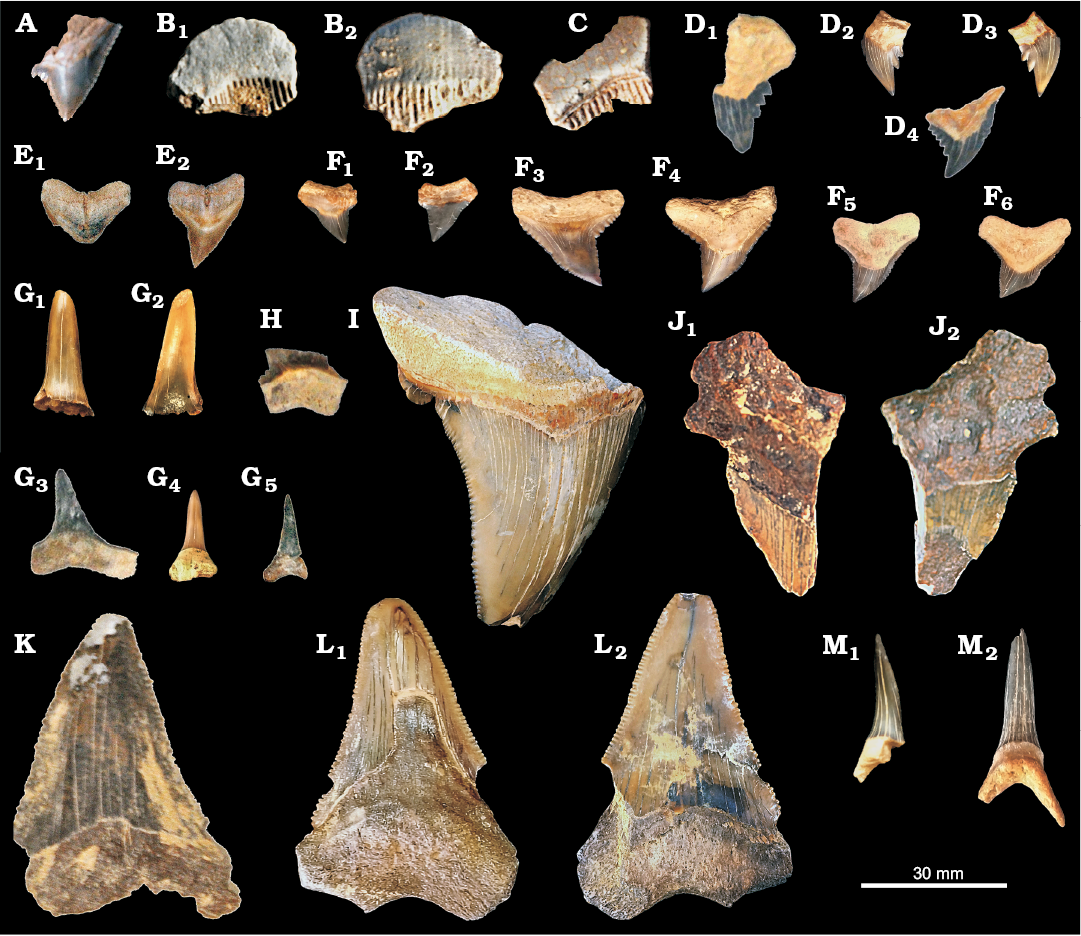
Fig. 12. A–C. Carcharhiniformes and Myliobatiformes from the BOTM, early Oligocene, Minqar Tibaghbagh, Qattara Depression, Egypt; photographed and left in the field. A. Carcharhinus sp., incomplete upper tooth in lingual view. B, C. “Aetobatus” sp. B. Lower tooth in occlusal (B1) and basal (B2) views. C. Lower tooth in occlusal view. D–M. Carcharhiniformes and Lamniformes from the BOS, early Oligocene, Minqar Tibaghbagh, Qattara Depression, Egypt. D. Hemipristis cf. serra Agassiz, 1835 (1843) (CGM67195), upper lateral teeth in lingual (D1, D2, D4) and labial (D3) views. E. Carcharhinus cf. perseus Adnet, Antoine, Hassan Baqri, Crochet, Marivaux, Welcomme, and Métais, 2007 (CGM67194), upper antero-lateral teeth in lingual view. F. Carcharhinus sp. (CGM67195), upper teeth in lingual (F1, F4, F5, F6) and labial (F2, F3) views. G. Negaprion frequens (Dames, 1883) (CGM67191), lower teeth in lingual (G1, G3, G4) and lateral (G2, G5) views. H. Galeocerdo sp. (CGM67195) in lingual view. I–L. Otodus (Carcharocles) cf. sokolowi. I. CGM67195, upper tooth in lingual view. J. CGM69186 upper tooth in lingual (J1) and labial (J2) views. K. CGM69186, lower tooth in labial view. L. CGM69186, lower tooth in lingual (L1) and labial (L2) views. M. Carcharias? sp. (CGM67195), lower teeth in lateral (M1) and lingual (M2) views.
Genus Negaprion Whitley, 1940
Type species: Aprionodon acutidens queenslandicus Whitley, 1939; Recent in tropical Atlantic and Indo-Pacific oceans.
Negaprion frequens Dames, 1883
Fig. 12G.
Material.—41 mostly damaged teeth (CGM67191: 13, CGM67194: one, CGM67195: 27) from the BOS, early Oligocene, Minqar Tibaghbagh, Qattara Depression, Egypt. Dimensions: height 6–22 mm, width 3–10 mm.
Description.—Teeth are small and slender. There is a single slender erect cusp, which is somewhat distally inclined in posterior teeth but more commonly vertical. This is unornamented and has a smooth cutting edge. There are very weakly developed lateral extensions of the crown on the upper edge of the root. The root is low and straight to somewhat bent basally.
Remarks.—Teeth are very similar to typical specimens of Negaprion frequens seen elsewhere in North Africa (Adnet et al. 2011; Underwood et al. 2011). Negaprion frequens from the Daba’a Formation at Minqar Tibaghbagh has been described by Zalmout et al. (2012). Negaprion frequens is known from the late Eocene and early Oligocene of Egypt, and the middle and late Eocene of South Western Morocco in Africa, the middle Eocene of Qatar and late Eocene of Jordan in Asia (Zalmout et al. 2012).
Subfamily Galeocerdinae Whitley, 1934
Genus Galeocerdo Müller and Henle, 1838
Type species: Squalus (Galeocerdo) cuvier Peron and Lesueur in Lesueur, 1822; Recent in tropical and temperate waters.
Galeocerdo sp.
Fig. 12H.
Material.—One damaged tooth (CGM67195) from the BOS, early Oligocene, Minqar Tibaghbagh, Qattara Depression, Egypt. Dimensions: height 12 mm, width 12 mm.
Description.—The single tooth is very incomplete and specifically indeterminable. The crown is low and has a strongly distally inclined cusp. The cutting edges of the cusp are finely, but clearly serrated. There is a well-developed notch at the distal base of the crown with a small part of the distal heel preserved. This has coarser serrations than the main cusp. The root is high and linguolabially compressed.
Remarks.—Galeocerdo spp. from the Daba’a Formation at Minqar Tibaghbagh has been described by Van Vliet and El-Kheir (2010) and Zalmout et al. (2012). The genus Galeocerdo is known from the lower Eocene, Ypresian to Recent; Africa, Europe, North and South America, and Asia in tropical and temperate oceans (Cappetta 2012).
Family Hemigaleidae Hasse, 1879
Genus Hemipristis Agassiz, 1835
Type species: Hemipristis serra Agassiz, 1835 (1843); Miocene of southern Germany.
Hemipristis cf. serra Agassiz, 1835 (1843)
Fig. 12D.
Material.—Nine teeth (CGM67186: one, CGM67191: one, CGM67195: seven), three badly damaged, from the BOS, early Oligocene, Minqar Tibaghbagh, Qattara Depression, Egypt. Dimensions: height 9–23 mm, width 5–22 mm.
Description.—Teeth are highly distinctive. The cusp is strongly curved distally, with the tip of the cusp being approximately above the tip of the distal root lobe. The large serrations on the mesial edge of the cusp are only present close to the tip, whilst larger serrations still are present on the distal cusp edge, being largest in the mid, most concave part of the cusp. The root is high and raised in the central part with a robust labial protuberance. Only upper teeth have been collected.
Remarks.—The teeth of Hemipristis cf. serra are larger than those of H. curvatus Dames, 1883 at the middle to late Eocene sites of the Fayum Depression. The length of the H. cf. serra teeth from the BOS at Minqar Tibaghbagh is larger than a figured tooth of H. curvatus (7.1 mm in length) from “site 26” of the Priabonian Birket Qarun Formation, the Fayum Province (Underwood et al. 2011: fig. 5b). The larger size is suggestive of a younger geological age. Some teeth have the same overall morphology as H. curvatus, with only small serrations at the mesial edge, but one tooth (the largest) has larger serrations at this side. This tooth bears a strong resemblance to H. serra (Bourdon 2011). An origin from Miocene layers higher in the succession is possible for this unexpectedly large tooth. Similar teeth from the early Oligocene of Balochistan, Pakistan were described as H. cf. serra Agassiz, 1843 by Adnet et al. (2007). Teeth of H. cf. serra can be distinguished from H. curvatus by being larger and by the presence of more than three large serrations on the mesial edge of the upper teeth. The only weak serrations of the mesial edge, slighter than in typical H. serra teeth are suggestive of a transitional form between H. curvatus and H. serra (Adnet et al. 2007). Whilst this Oligocene species probably represents an unnamed species, naming this is beyond the scope of this study. Hemipristis cf. serra is known from the Eocene of Saudi Arabia, the Oligocene of Oman and Pakistan in Asia and of South Carolina, North America. The genus Hemipristis is known from the middle and late Eocene of Europe, Africa, North and South America, and Asia to Recent in the Indian Ocean (Cappetta 2012).
Order Lamniformes Berg 1937
Family Otodontidae Glikman, 1964
Genus Otodus Agassiz, 1838
Type species: Otodus obliquus Agassiz, 1838; Ypresian of the United Kingdom.
Otodus (Carcharocles) cf. sokolowi Jaekel, 1895
Fig. 12I–L.
Material.—Ten (CGM69186: five, CGM67191: four, CGM 69195: one), often badly damaged, from the BOS, early Oligocene, Minqar Tibaghbag, Qattara Depression, Egypt. Dimensions: height 20–54 mm, width 18–40 mm.
Description.—Teeth are large and prominent. The cusp is higher than wide and slightly curved distally. Small, rounded lateral cusplets are present at the base of the main cusp. The cutting edge of cusp and cusplets is covered with small and very regular serrations. The root is robust and wider than the crown, with distinct root lobes.
Remarks.—A relatively large sample of Otodus cf. sokolowi Jaekel, 1895 has been found, which is most certainly a collecting bias, as these conspicuous teeth are easy to spot in the field. Otodus cf. sokolowi Jaekel, 1895 lived until the early Oligocene (Bourdon 2011). It could be a transitional form to Otodus angustidens Agassiz, 1843, but the teeth are too incomplete to be certain about it. Otodus sokolowi has been described from the Daba’a Formation at Minqar Tibaghbagh (as Carcharocles auriculatus) by Van Vliet and El-Kheir (2010) and by Zalmout et al. (2012).It is known from Europe, the Eocene of Germany (Diedrich 2011); Asia, the Paleogene of southern Russia (Jaekel 1895), the Eocene of Uzbekistan (Case et al. 1996), the Eocene of Syria and Jordan; Africa, the Eocene of Egypt, Morocco, Nigeria, Congo, and Angola; North America, the Eocene of North Carolina, Georgia, and Alabama (Zalmout et al. 2012).
Family “Odontaspididae” sensu lato (polyphyletic)
Genus Carcharias? Rafinesque, 1810
Type species: Carcharias taurus Rafinesque, 1810; Recent in subtropical and temperate oceans.
Carcharias? sp.
Fig. 12M.
Material.—Two partial teeth (CGM67195), from the BOS, early Oligocene, Minqar Tibaghbagh, Qattara Depression, Egypt. Dimensions: height 11–28 mm, width 10–13 mm.
Description.—Teeth slender and high with a rather straight, unornamented main cusp. The root is strongly bilobed. The shape of the root, and presence of lateral cusplets, is, due to some damage, unknown.
Remarks.—Carcharias sp. from the Daba’a Formation at Minqar Tibaghbagh has been described by Van Vliet and El-Kheir (2010) and Zalmout et al. (2012). Teeth are rare in the Eocene of Egypt (Zalmout et al. 2012) and seem to be absent from the early Oligocene Jebel Qatrani Formation of the Fayum, Egypt. The genus Carcharias is known from the Cenomanian to Recent of Europe, North America, Africa, and Far East in tropical and warm oceans (Cappetta 2012).
Additional finds
Rib fragments of Sirenia, shark teeth (Carcharhinus sp., see Fig. 12A), ray teeth (“Aetobatus” spp., see Fig. 12B, C), and gastropods (Potamides sp.) occurring in the BOTM (early Oligocene, Minqar Tibaghbagh, Qattara Depression, Egypt) are proof of marine influences. In the whole Oligocene sequence from BOTM to BOS at Minqar Tibaghbagh, sirenian remains are not uncommon. Also, two weathered skeletons have been observed in the upper sections. Ribs and rib fragments are easily recognizable as sirenian by being osteosclerotic (Zalmout 2008). Pachyosteosclerotic rib fragments like those of Eotheroides (Zalmout 2008) have not been recorded from this section. Both Protosiren and Eosiren have osteosclerotic, not pachyosteosclerotic ribs (Zalmout 2008), but Protosiren spp. are only known from the Lutetian to early Priabonian (Domning et al. 2010). As only Eosiren (E. imenti; Domning et al. 1994) is known from the early Oligocene of the Fayum Depression, Egypt (Zalmout 2008), we provisionally assign the remains to cf. Eosiren sp.
In the BOTM a severely weathered and damaged skull in association with some vertebrae, was seen, tentatively assigned to Crocodylus sp. In the whole local sequence, from the BOTM to the BOS, turtle bones and crocodylian osteoderms do occur, at places being rather common. Also gastropods belonging to the genus Potamides are common in the whole section, in some strata abundant. For an overview of the vertebrate fauna from the early Oligocene at Minqar Tibaghbagh, see Table 4.
Table 4. Vertebrates from the BOTM and BOS, early Oligocene, Minqar Tibaghbagh, Qattara Depression, Egypt.
|
Vertebrates |
BOTM |
BOS |
|
Mammalia |
||
|
Proboscidea, Palaeomastodontidae, cf. Phiomia sp. |
+ |
- |
|
Hyracoidea, cf. Antilohyrax sp. |
+ |
- |
|
Sirenia, Dugongidae, cf. ?Eosiren sp. |
+ |
+ |
|
Anthracotheriidae, cf. Bothriogenys sp. |
+ |
- |
|
Reptilia |
||
|
Crocodylia, cf. Crocodylus sp. |
+ |
+ |
|
Testudines, Cheloniidae, gen. et sp. indet. |
+ |
+ |
|
Elasmobranchii |
||
|
Hemigaleidae, Hemipristis cf. serra |
- |
+ |
|
Carcharhinidae, Carcharhinus sp. |
+ |
+ |
|
Carcharhinus cf. perseus |
- |
+ |
|
Negaprion cf. frequens |
- |
+ |
|
Galeocerdo sp. |
- |
+ |
|
Otodontidae, Otodus cf. sokolowi |
- |
+ |
|
?Carcharias sp. |
- |
+ |
|
Myliobatidae, “Aetobatus” sp. |
+ |
- |
Discussion
Age and stratigraphy.—No biostratigraphically useful invertebrates or microfossils were recognized in the section described. Regarding the lowest part of the section, the BOTM, the terrestrial mammal fauna with the afrotheres paleomastodonts, hyracoids, sirenians, and with anthracotheres is typical for the Paleogene of Afro-Arabia. The presence of Phiomia sp. in the BOTM is almost certainly proof of an Oligocene age (Sanders et al. 2010a). The three described Phiomia molars appear to have had a relatively large size, although the original dimensions of two molars had to be estimated. This could maybe indicate a somewhat younger age than Phiomia serridens from the early Oligocene Jebel Qatrani Formation in the Fayum Depression, but certainly older than the late Oligocene Phiomia major from Ethiopia.
Contrary to this, the astragalus of cf. Antilohyrax sp. could possibly indicate an earliest Oligocene age. Antilohyrax pectidens is thus far only known from quarry L-41 at the base of the Jebel Qatrani Formation that is considered to be deposited in the earliest Oligocene (Gingerich 1993; Underwood et al. 2013) or maybe latest Eocene (Rasmussen and Simons 2000; Seiffert 2010). More investigations are necessary to confirm the presence of Antilohyrax sp. in the early Oligocene of Tibaghbagh and infer its significance for age determination. The described astragalus of an anthracothere, cf. Bothriogenys sp., is intermediate in size between a late Eocene anthracothere astragalus cf. Bothriogenys sp., and early Oligocene anthracothere astragali, cf. Bothriogenys sp. from the upper part of the Jebel Qatrani Formation (quarries I, M, and O in the Upper Fossil Wood Zone) in the Fayum Depression described by Sileem and Hewaidy (2015). This intermediate size could also point to a somewhat earlier age than the upper part of the Jebel Qatrani Formation. The meaning of this intermediate size is, however, not clear, as other factors (e.g., the ontogenic age of the specimen, intraspecies or interspecies variation) could also influcence the dimensions of the astragalus. As for now, the exact age of the BOTM is yet uncertain.
The selachian fauna of the BOS, here some 50 m higher than the BOTM, unquestionably points at a Paleogene age too. More specifically, the occurrence of Hemipristis cf. serra is indicative of an Oligocene age. Reworking in the Miocene of the selachian teeth from older sediments cannot be completely ruled out, but lack of abrasion on the specimens makes this unlikely. This marine fauna on genus level appears to be very persistent, without indications of a turnover at the Eocene–Oligocene (Murray et al. 2014). Some species recovered are known from the latest Eocene sediments of the Fayum Depression in Egypt and from Morocco (Adnet et al. 2010), as well as from the early Oligocene of the Eastern Tethys Ocean (Adnet et al. 2007). For comparison with other Oligocene selachian faunas from the Eastern Tethys Ocean, see Table 5.
Table 5. Comparison of selachians from the BOTM and BOS, early Oligocene, Minqar Tibaghbagh, Qattara Depression, Egypt, with selachian faunas of the early Oligocene of Eastern Tethys Ocean. * Frequencies of the chondrichthyan species are only a rough estimation, as only a small number of teeth has been collected by surface prospecting. Abbreviations: –, absent; +–+++, rare–abundant; ?, dubious.
| |
Egypt: Qattara Depression, Minqar Tibaghbagh |
Egypt: |
Oman: |
Pakistan: |
||||
|
CGM67186 BOS* |
CGM67191 BOS* |
CGM67194 BOS* |
CGM67195 BOS* |
BOTM |
||||
|
Reference |
this paper |
this paper |
this paper |
this paper |
this paper |
Thomas et al. 1989 |
||
|
Carcharhiniformes |
||||||||
|
Carcharhinus sp. |
– |
+ |
|
++ |
+ |
+ / +++ |
+ |
+ / +++ |
|
Carcharhinus cf. perseus |
|
|
+ |
|
– |
++ |
+ |
+/+++ |
|
Negaprion cf. frequens |
– |
+++ |
+ |
+++ |
– |
? |
+ |
– / ++ |
|
Galeocerdo sp. |
– |
– |
|
+ |
– |
+ |
– |
– |
|
Hemipristis cf. serra |
+ |
+ |
|
++ |
– |
– |
+ |
– / ++ |
|
Lamniformes |
||||||||
|
Otodus cf. sokolowi |
+ |
+ |
|
+ |
– |
– |
– |
– |
|
Carcharias sp. |
– |
– |
|
+ |
– |
– |
– |
– |
|
Myliobatiformes |
||||||||
|
“Aetobatus” sp. |
– |
– |
|
+ |
+ |
+ |
+ |
– / + |
The whole sequence from the BOTM to the BOS is considered to consist of Oligocene sediments, maybe referable in age to the Jebel Qatrani Formation based on its fossil content. Because the age of strata immediately above the BOS has not yet been determined, the total thickness of the Oligocene strata at Tibaghbagh is yet unknown. This sequence has previously been regarded as early Miocene in age and was included into the fluvio-marine Miocene Moghra Formation or its lateral equivalent, the marine Mamura Formation (Hantar 1990; Tawadros 2001: 396; Zalmout et al. 2012). This means that a considerable part, more than 75 m, of the succession in the northern escarpments of Tibaghbagh consists of Paleogene sediments: 24 m of the Daba’a Formation, overlain by at least 50 m of Oligocene strata.
Orabi et al (2015) described two sections, at the El-Arag Oasis and the El-Qara Oasis, with early Oligocene sediments. Tibaghbagh is situated right between both places: the El-Arag Oasis is 31 km south and the El-Qara Oasis 49 km north of Tibaghbagh.
At El-Qara Oasis, early Oligocene (Rupelian) sediments were reported, as is indicated by foraminifera in the upper part, called by the authors the El-Qara Formation. It consists of gypsiferous shales and cross-bedded limestones beds, and is about 45,5 m thick. The El-Qara Formation is supposedly deposited in a lagoonal to shallow subtidal environment.
At El-Arag Oasis a section of 24.5 m thick, assigned by the authors to the early Oligocene Jebel Qatrani Formation, consists of yellow to greenish yellow sandstone, calcareous sandstone with quartz pebbles.
Environmental conditions of the alleged Jebel Qatrani Formation at El-Arag Oasis were not provided. Organic remains are scarce, but the authors mentioned “quantities of silicified wood, vertebrate bone fragments and few fragments of Mollusca” (Orabi et al. 2015). The presence of silicified wood and bone fragments are reminiscent of the BOTM at Minqar Tibaghbagh, although here fossils are common in the whole sequence from the BOTM to the BOS. For a comparison of the Paleogene strata at Minqar Tibaghbagh with Paleogene strata in the Fayum Depression, and El-Qara and El-Arag in the Qatara Depression, see Fig. 3.
Environmental conditions.—The fauna of the BOTM, with the presence of Potamides sp., the shark Carcharhinus sp., the ray “Aetobatus” sp., and sirenian bones in the same bed as the terrestrial mammals, are indicative of a marine environment. As the former animals could survive in brackish water, a near coastal, fluvial origin like the Priabonian sediments in quarry BQ2 in the Fayum Depression, is possible too (Bown et al. 1982; Seiffert et al. 2008). Fossil wood and terrestrial mammal remains are indicative of fluvial influences. Not to be excluded is the possibility that the sandstone layer, marking the end of the Daba’a Formation, indicates a marine regression with temporally terrestrial depositional conditions, and again followed by a transgression phase in which the marine fauna was deposited.
The sequence from BOTM to BOS appears to be marine or at least quasi-marine as it contains at places abundant Potamides and occasionally chelonian and sirenian bones.
In the BOS, Negaprion sp. and Carcharhinus sp. are likely the most abundant species, which could indicate a littoral habitat (Murray et al. 2014). However, the presence of the large lamniformes O. sokolowi and Carcharias sp. indicates fully marine environmental conditions.
Comparison with Oligocene terrestrial mammal sites in Egypt and Libya.—The most important sites in North Africa yielding Paleogene terrestrial mammals comprise the Fayum Depression in Egypt and Dor El-Talha in Libya, referred to by Arambourg (1963) as the Nilotic-Saharian Zone. The new site of Minqar Tibaghbagh is located between those two sites: about 400 km west of Birket Qarun in the Fayum Depression of Egypt and about 825 km east of Dor El-Talha, Libya. The faunas of the Jebel Qatrani Formation in the Fayum Depression and the Idam Unit of Dor El-Talha are probably more or less contemporaneous, early Oligocene in age (Seiffert 2010) and comparable to the early Oligocene strata of Minqar Tibaghbagh.
In contrast to what seems the preponderantly marine Oligocene deposits at Minqar Tibaghbagh, the Jebel Qatrani Formation at the Fayum Depression consists of a varied suite of fluvial clastic sediments, for the most part deposited in fresh water conditions, with marine influences at some places (Murray et al. 2014; Underwood et al. 2013). Fossil wood and plant remains do occur and mangrove rhizoliths are abundant at the base of the Formation in the Fayum Depression (Simons and Rasmussen 1990). Although there is no direct evidence of marine deposition, the presence of sirenian and chondrichthyan remains (Murray et al. 2014), shows that the sea was nearby and a tidal influence cannot be ruled out.
The Evaporite Unit and the Idam Unit of Dor El-Talha consist of mudstone, siltstone, and sandstone lenses. Both units appear to be part of a lagoonal-deltaic complex, the lower part of which contains tidal channels, overlain by a unit of channel-dominated fluvial facies with abundant silicified wood (Rasmussen et al. 2008). For comparison of the early Oligocene mammal fauna at Minqar Tibaghbagh with the early Oligocene mammal faunas from the Fayum Depression, Egypt and Dor El-Talha, Libya, see Table 6. It is shown that all genera found at Tibaghbagh are known from the early Oligocene Jebel Qatrani Formation of the Fayum Depression and some also from the early Oligocene Idam Unit of Libya.
Table 6. Comparison of the mammal fauna from BOTM and BOS, early Oligocene, Minqar Tibaghbagh, Qattara Depression, Egypt, with mammal faunas from the Jebel Qatrani Formation, Fayum, Egypt and Dor El-Talha, Libya. 1 this paper; 2 Sanders et al. 2010; 3 Rasmussen and Simons 2000; 4 Rasmussen et al. 2008; 5 Rasmussen and Gutiérrez 2010; 6 Zalmout 2008; 7 Holroyd et al. 2010.
| |
Egypt:
|
Egypt:
|
Egypt:
|
Libya: |
|
Proboscidea, Palaeomastodontidae |
||||
|
Phiomia sp. indet. |
+ 1 |
|
|
|
|
Phiomia serridens |
|
|
+ 2 |
+ 2 |
|
Hyracoidea |
||||
|
cf. Antilohyrax sp. |
+ 1 |
|
|
|
|
Antilohyrax pectidens |
|
|
+ 3 |
|
|
20 spp. |
|
|
+ 5 |
+ 4 |
|
Sirenia, Dugongidae |
||||
|
Sirenia indet. |
+ 1 |
|
|
+ 6 |
|
cf. Eosiren sp.? |
|
+ 1 |
|
|
|
Eosiren imenti |
|
|
+ 6 |
|
|
Anthracotheroidea |
||||
|
cf. Bothriogenys sp. |
+ 1 |
|
|
|
|
Bothriogenys
spp. |
|
|
+ 7 |
|
Comparison of the BOS at Minqar Tibaghbagh with the selachian fauna of the Jebel Qatrani Formation in the Fayum.—The samples from the BOS are not large and by surface prospecting small species most probably have been overseen. Nevertheless, a preliminary comparison will be made. O. sokolowi, Carcharias sp., and Hemipristis cf. serra from the BOS at Minqar Tibaghbagh are absent in the Jebel Qatrani Formation of the Fayum Depression (Murray et al. 2014). As for Carcharhinus species, the lower and mid part of the Jebel Qatrani Formation in the Fayum Depression have abundant teeth of C. perseus (Murray et al. 2014), and this species seems to be less frequent in these rather small samples. These faunal differences are most likely due to the environmental conditions in which the sediments were deposited. This is, fully marine for the BOS at Minqar Tibaghbagh, mostly fresh water with marine influences at some places for the Jebel Qatrani Formation.
Conclusions
The new terrestrial mammal site of Minqar Tibaghbagh fills a gap between the well-known localities at the Fayum Depression in Egypt and Dor El-Talha in Libya. It is not only to be expected that this new site will yield fossils of more taxa and genera, but also that more sites with terrestrial mammals will be discovered in the region, considering the presence of comparable strata of the supposedly Jebel Qatrani Formation in El-Arag. The problem of seemingly contradictory indications regarding the age of the BOTM (see above) have to be resolved in future research. The Oligocene elasmobranch fauna of Minqar Tibaghbagh, indicative of a fully marine environment, clearly differs from that of the Jebel Qatrani Formation at the Fayum Depression, the latter being indicative for mostly fresh water depositional conditions, but with marine influences in the lower part of the Formation (Murray et al. 2014).
It is also different from selachian faunas of the Eastern Tethys Ocean in Pakistan and Oman, being probably deposited in littoral environmental conditions (Adnet et al. 2007). These first investigations show that the fossil sites of both the BOTM and BOS at Minqar Tibaghbagh will considerably contribute to the knowledge of Oligocene vertebrate faunas from Afro-Arabia.
Acknowledgments
We want to thank especially Moustafa M. Fouda (Director Nature Conservation Sector of the EEAA) and El-Baily E. Hatab (Director General of the Technical Office of the EEAA), who supported the fieldwork and arranged the necessary permissions. M.M. Fouda gave us permission to publish the newly found fossil sites at Minqar Tibaghbagh, also Ahmed S. Mohamed, and Khaled A. Harhash (all Project Managers of the EEAA), offered their help. Again we express our debt to the late Gabrial H. Abu El-Naga (Luxor, Egypt), who was our guide in Egypt and without whom we could not have reached this study area in Egypt. The Dutch authors, TMP, ASS, and HJV in particular would like to thank Gijsbert J. Boekschoten (the Vrije Universiteit, Amsterdam, The Netherlands), Kim Duistermaat (Netherlands-Flemish Institute in Cairo, Egypt), and Anja van de Put (Embassy of the Kingdom of the Netherlands in Cairo, Egypt), who assisted in establishing contacts with the appropriate Egyptian authorities. We want to thank William J. Sanders (University of Michigan, USA) for his help by identifying the palaeomastodont fossils. Also Lars Werdelin (Linköping University, Sweden) was helpful by his comments about the other terrestrial mammal fossils. Johannes G.M. Thewissen (Northeast Ohio Medical University, USA) helped by giving us literature about the early Oligocene terrestrial mammal fauna from the Fayum Depression. Finally, we thank the reviewers, Emmanuel Gheerbrant (Muséum National d’Histoire Naturelle, Paris, France), and Wilma Wessels (Universiteit van Utrecht, The Netherlands) for their helpful suggestions and remarks, which greatly improved the manuscript. We want to thank Mark D. Uhen (George Mason University, Fairfax, Virginia, USA) and Olivier Lambert (Institut royal des Sciences naturelles de Belgique, Bruxelles, Belgium), who have been very helpful to ameliorate the manuscript.
References
Adnet, S., Antoine, P.-O., Hassan Baqri, S.R., Crochet, J.-Y., Marivaux, L., Welcomme, J.-L., and Métais, G. 2007. New tropical carcharhinids (chondrichthyes, Carcharhiniformes) from the late Eocene–early Oligocene of Balochistan, Pakistan: Paleoenvironmental and paleogeographic implications. Journal of Asian Earth Sciences 30: 303–323. Crossref
Adnet, S., Cappetta, H., and Tabuce, R. 2010. A Middle–Late Eocene vertebrate fauna (marine fish and mammals) from southwestern Morocco; preliminary report: age and palaeobiogeographical implications. Geological Magazine 147: 860–870. Crossref
Adnet, S., Cappetta, H., Elnahas, S., and Strougo, A. 2011. A new Priabonian Chondrichthyans assemblage from the Western desert, Egypt: Correlation with the Fayum oasis. Journal of African Earth Sciences 61: 27–37. Crossref
Andrews, C.W. 1906. A Descriptive Catalogue of the Tertiary Vertebrata of the Fayûm, Egypt. 324 pp. British Museum of Natural History, London.
Andrews, C.W. and Beadnell, H.J.L. 1902. A preliminary note on some new mammals from the Upper Eocene of Egypt. Survey Department, Public Works Ministry, Cairo 1902: 1–9.
Antar, M.S.M. 2011. Paleo-environments of the Exposed Eocene Sediments Between Wadi El-Hitan and East Siwa in the Egyptian Western Desert Based on Their Faunal Content, Especially the Vertebrates. 186 pp. Zagazig University, Faculty of Science, Geology Department, Zagazig, Egypt.
Arambourg, C. 1963. Continental vertebrate faunas of the Tertiary of North Africa. In: F.C. Howell and F. Bourliere (eds.), African Ecology and Human Evolution, 55–60. Aldine, Chicago.
Arambourg, C. and Burollet, P.F. 1962. Reste de Vertébrés oligocènes en Tunisie centrale. Comptes Rendus Sommaire des Séances de la Société Géologique de France 2: 42–43.
Bourdon, J. 2011. The Life and Times of Long Dead Sharks. Paleo-genera. Genera from the Fossil Record. www.Elasmo.com.
Bown, T.M., Kraus, M.J., Wing, S.L., Fleagle, J.G., Tiffney, B.H., Simons, E.L., and Vondra, C.F. 1982. The Fayum Primate Forest Revisited. Journal of Human Evolution 11: 603–632. Crossref
Cappetta, H. 2012. Handbook of Paleoichtyology. Volume 3E. Chondrichthyes, Mesozoic and Cenozoic Elasmobranchii: Teeth. 512 pp. Verlag Dr. Friedrich Pfeil, München.
Case, G.R., Udovichenko, N.I., Nessov, L.A., Averianov, A.O., and Borodin, P.D. 1996. A Middle Eocene selachian fauna from the White Mountain Formation of the Kizylum Desert, Uzbekistan, C.I.S. Palaeontographica Abteiling A 242: 99–126.
Coppens, Y., Maglio, V.J., Madden, C.T., and Beden, M. 1978. Proboscidea. In: V.J. Maglio and H.B.S. Cooke (eds.), Evolution of African Mammals, 336–367. Harvard University Press, Cambridge.
Coster, P.M.C., Beard, K.C., Salem, M.J., Chaimanee, Y., Brunet, M., and Jaeger, J.-J. 2015. A new early Oligocene mammal fauna from the Sirt Basin, central Libya: Biostratigraphic and paleobiographic implications. Journal of African Earth Sciences 104: 43–55. Crossref
Diedrich, C. 2011. The world’s oldest fossil record. Natural Science 3: 914–920. Crossref
Domning, D.P., Zalmout, I.S., and Gingerich, P.D. 2010. Sirenia. In: L. Werdelin and W.J. Sanders (eds.), Cenozoic Mammals of Africa, 147–160. University of California Press, Berkeley.
Ducrocq, S., Benammi, M., Chavasseau, O., Chaimanee, Y., Suraprasit, K., Pha, P., Phuong, V., Phach, P., and Jaeger, J.-J. 2015. New anthracotheres (Cetartiodactyla, Mammalia) from the Paleogene of northeastern Vietnam: biochronological implications. Journal of Vertebrate Paleontology 35: e929139. Crossref
Gheerbrant, E., Sudre, J., Sen, S., Abrial, C., Marandat, B., Sigé, B., and Vianey-Liaud, M. 1998. Nouvelles données sur les mammifères du Thanétien et de l’Yprésien du Bassin d’Ouarzazate (Maroc) et leur contexte stratigraphique. Palaeovertebrata 27: 155–202.
Gingerich, P.D. 1993. Oligocene age of the Gebel Qatrani Formation, Fayum, Egypt. Journal of Human Evolution 24: 207–218. Crossref
Gutiérrez, M. 2011. Taxonomic and Ecological Characterization of a Late Oligocene Mammalian Fauna from Kenya. 368 pp. Unpublished Ph.D. Dissertation, Washington University in St. Louis, St. Louis.
Hantar, G. 1990. North Western Desert. In: R. Said (ed.), The Geology of Egypt, 293–319. A.A.Balkema, Rotterdam.
Holroyd, P.A., Lihoreau, F., Gunnel, G.F., and Miller, E.R. 2010. Anthracotheriidae. In: L. Werdelin and W.J. Sanders (eds.), Cenozoic Mammals of Africa, 843–851, University of California Press, Berkeley.
Holroyd, P.A., Simons, E.L., Bown, T.M., Polly P.D., and Kraus, M.J. 1996. New records of terrestrial mammals from the upper Eocene Qasr El Sagha Formation, Fayum Depression, Egypt. In: M. Godinot and P.D. Gingerich (eds.), Paleobiologie et Evolution des Mammifères du Paléogène: Volume Jubilaire en Hommage à Donald E. Russell. Palaeovertebrata 25: 175–192.
Jaekel, O.1895. Unter-Tertiäre Selachier aus Südrussland. Mémoirs du Comité géologique de St. Pétersbourg 9: 19–35.
King, C., Underwood, C.J., and Steurbaut, E. 2014. Eocene stratigraphy of the Wadi Al-Hitan World Heritage Site and adjacent areas (Fayum, Egypt). Stratigraphy 11: 185–234.
Matsumoto, H. 1924. A revision of Palaeomastodon dividing it into two genera, and with descriptions of two new species. Bulletin of the American Museum of Natural History 50: 1–58.
Murray, A.M., Argyriou, T., and Cook, T.D. 2014. Palaeobiogeographic relationships and palaeoenvironmental implications of an earliest Oligocene Tethyan ichthyofauna from Egypt. Canadian Journal of Earth Sciences 51: 909–918. Crossref
Orabi, H., El Beshtawy, M., Osman, R., and Gadallah, M. 2015. Larger benthic foraminiferal turnover across the Eocene–Oligocene transition at Siwa Oasis, Western Desert, Egypt. Journal of African Earth Sciences 105: 85–92. Crossref
Pickford, M. 2015a. Bothriogenys (Anthracotheriidae) from the Bartonian of Eoridge, Namibia. Communications of the Geological Survey of Namibia 16: 215–222.
Pickford, M. 2015b. Large ungulates from the basal Oligocene of Oman. 3 Anthracotheriidae. Spanish Journal of Palaeontology 30: 257–264.
Rasmussen, D.T. and Simons, E.L. 2000. Ecomorphological diversity among Paleogene hyracoids (Mammalia): a new cursorial browser form the Fayum, Egypt. Journal of Vertebrate Paleontology 20: 167–176. Crossref
Rasmussen, D.T. and Guetiérrez, M. 2010. Hyracoidea. In: L. Werdelin and W.J. Sanders (eds.), Cenozoic Mammals of Africa, 123–145. University of California Press, Berkeley, Los Angeles, London.
Rasmussen, D.T., Gagnon, M., and Simons, E.L. 1990. Taxeopody in the carpus and tarsus of Oligocene Pliohyracidae (Mammalia: Hyracoidea) and the phyletic position of Hyraxes. Proceedings of the National Academy of Sciences of the United States of America 87: 4688–4691. Crossref
Rasmussen, D.T., Tshakreen, S.O., Abugares, M.M., and Smith, J.B. 2008. Return to Dor al-Talha. Paleontological Reconnaissance of the Early Tertiary of Libya. In: J.G. Fleagle and C.C. Gilbert (eds.), Elwyn Simons: A Search for Origins, 181–196. Springer Press, New York. Crossref
Rose, K.D. 2006. The Beginning of the Age of Mammals. 428 pp. The John Hopkins University Press, Baltimore.
Sanders, J.W., Gheerbrant, E., Harris, J.M., Saegusa, H., and Delmer, C. 2010a. Proboscidea. In: L. Werdelin and W.J. Sanders (eds.), Cenozoic Mammals of Africa, 161–251. University of California Press, Berkeley.
Sanders, J.W., Kappelman, J., and Rasmussen, D.T. 2004. New large-bodied mammals from the late Oligocene site of Chilga, Ethiopia. Acta Paleontologica Polonica 49: 365–392.
Sanders, J.W., Rasmussen, T.B., and Kappelman, J. 2010b. Embrithopoda. In: L. Werdelin and W.J. Sanders (eds.), Cenozoic Mammals of Africa, 161–251. University of California Press, Berkeley.
Seiffert, E.R. 2010. Chronology of Paleogene mammal localities. In: L. Werdelin and W.J. Sanders (eds.), Cenozoic Mammals of Africa, 19–43. University of California Press, Berkeley. Crossref
Seiffert, E.R., Bown, T.M., Clyde, W.C., and Simons, E.L. 2008. Geology, paleoenvironment, and age of Birket Qarun locality 2 (BQ-2), Fayum Depression, Egypt. In: J.G. Fleagle and C.C. Gilbert (eds.), Elwyn Simons: A Search for Origins, 71–86. Springer Press, New York.
Shata, A.A. 1953. An account of the geology of el Hemeimat area lying between the Qattar and Sewa Depressions, Western Desert of Egypt. Bulletin de l’Institut du Désert d’Egypte 3: 108–113.
Sileem, A.H. and Hewaidy, A.G.A. 2015. New postcranial specimens of the Anthracotheriidae (Mammalia: Artiodactyla) from the Paleogene of Fayum Depression, Egypt. International Journal of Scientific Engineering and Applied Science (USEAS) 1: 376–391.
Simons, E.L. and Rasmussen, D.T. 1990. Vertebrate paleontology of Fayum: History of research, faunal review and future prospects. In: R. Said (ed.), The Geology of Egypt, 627–638. A.A. Balkema, Rotterdam.
Tabuce, R., Marivaux, L., Adaci, M., Bensalah, M., Hartenberger, J.-L., Mahboubi, M., Mebrouk, F., Tafforeau, P., and Jaeger, J.-J. 2007. Early Tertiary mammals from North Africa reinforce the molecular Afrotheria clade. Proceedings of the Royal Society of London B: Biological Sciences 274: 1159–1166. Crossref
Tawadros, E.E. 2001. Geology of Egypt and Libya. 468 pp. A.A. Balkema, Rotterdam.
Tobien, H. 1978. The structure of the mastodont molar (Proboscidea, Mammalia) Part 3: The Oligocene mastodont genera Palaeomastodon, Phiomia and the Eo/Oligocene paenungulate Moeritherium. Mainzer geowissenschafftliche Mitteilungen 6: 177–208.
Tsubamoto, T. and Tsogtbaatar, K. 2008. New specimens of anthracotheriid artiodactyls from the upper Eocene Ergilin Dzo Formation of Mongolia. Paleontological Research 12: 371–386. Crossref
Tsubamoto, T., Koda, Y., Hasegawa, Y., Nabana, S., and Tomida, Y. 2015. Paleogene mammals from the Iwaki Formation in Japan: Their implications for the geologic age and paleobiography of this formation. Journal of African Sciences 108: 18–32. Crossref
Underwood, C.J., King, C., and Steurbaut, E. 2013. Eocene initiation of Nile drainage due to East African uplift. Palaeogeography, Palaeoclimatology, Palaeooecology 392: 138–145. Crossref
Underwood, C.J., Ward, D.J., King, C., Antar, S.M., Zalmout, I.S., and Gingerich, P.D. 2011. Shark and ray faunas in the Middle and Late Eocene of the Fayum Area, Egypt. Proceedings of the Geologists’ Association 122: 47–66.
Van Vliet, H.J. and El-Kheir, G.A. 2010. A new Eocene marine mammal site in the Qattara depression (Egypt). Cainozoic Research 7: 73–77.
Zalmout, I.S. 2008. Late Eocene Sea Cows (Mammalia, Sirenia) from Wadi Al Hitan in the Fayum Basin, Egypt. 382 pp. Unpublished Ph.D. Dissertation, University of Michigan, Michigan.
Zalmout, I.S., Antar, M.S.M., Shafy, E.A., Metwally, M.H., Hatab, E., and Gingerich, P.D. 2012. Priabonan sharks and rays (Late Eocene: Neoselachii) from Minqar Tabaghbagh in the Western Qattara Depression, Egypt. Contributions from the Museum of Paleontology, University of Michigan 32: 71–90.
Zalmout, I.S., Sanders, W.J., MacLatchy, L.M., Gunnell, G.F., Al-Mufarreh, Y.A., Ali, M.A., Nasser, A.-A.H., Al-Masari, A.M., Al-Sobhi, S.A., Nadhra, A.O., Matari, A.H., Wilson, J.A., and Gingerich, P.D. 2010. New Oligocene primate from Saudi Arabia and the divergence of apes and Old World monkeys. Nature 466: 360–364. Crossref
Acta Palaeontol. Pol. 62 (3): 509–525, 2017
https://doi.org/10.4202/app.00341.2017